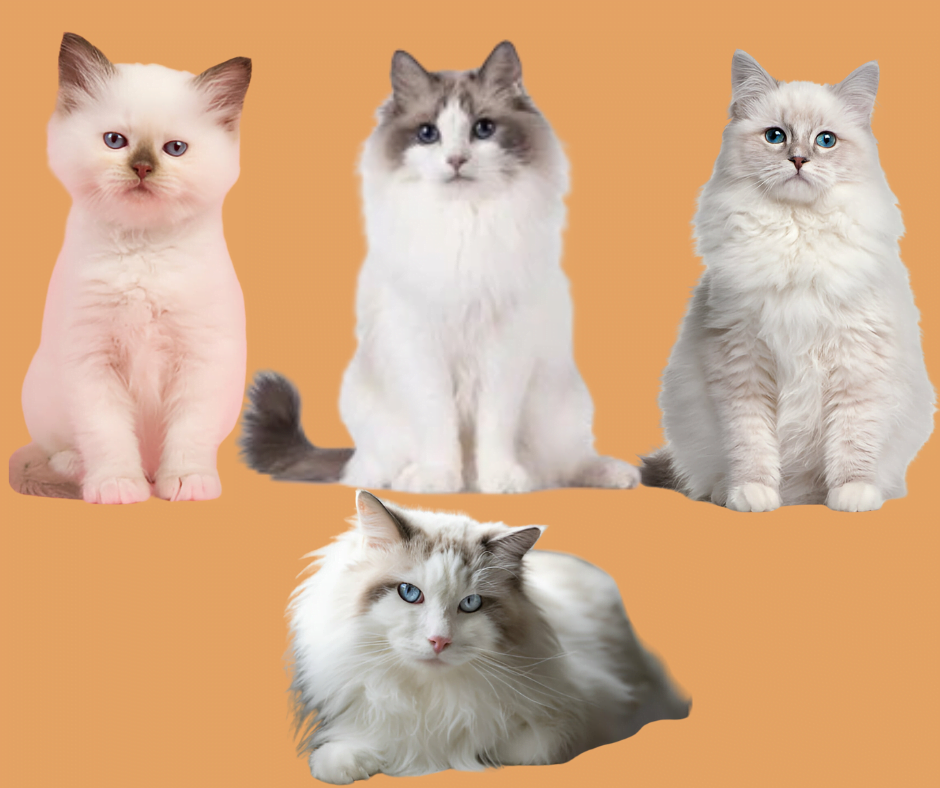Do You Know How Many Colors and Patterns The Ragdoll Cats Comes in?
Ragdoll cats are famous for their bright blue eyes, soft fur, and calm personality. These lovely cats are loved not only for their gentle nature but also for their variety of beautiful colors and patterns.
Understanding Ragdoll cats’ various colors and patterns is crucial in fully appreciating these unique felines. It also plays a significant role in making an informed decision about adopting or purchasing one.
Today, we’ll explore the 25 recognized colors and patterns of ragdoll cats. You’ll discover the different shades and markings that make each Ragdoll unique.
This guide covers everything you need to know for anyone charmed by cats, considering a Ragdoll as a pet, or simply curious about these beautiful Kittens.
Types of Ragdoll Cat Colors And Patterns
Ragdoll cats come in various colors and Patterns, such as deep seal, chocolate, softer blue, lilac, Colorpoint, Mitted, Bicolor, Tabby, and Tortie.
These colors highlight the breed’s unique blue eyes and silky fur, making them adored pets. Below, we will discuss them in detail.
List Of 6 Recognized Colors Of Ragdoll Cats
Ragdoll cats are recognized in six distinct colors: seal, blue, chocolate, lilac, red, and cream.
Each color has unique qualities and characteristics, adding to the diverse and beautiful appearance of the Ragdoll cat breed.
1. Seal Color Ragdoll Cats
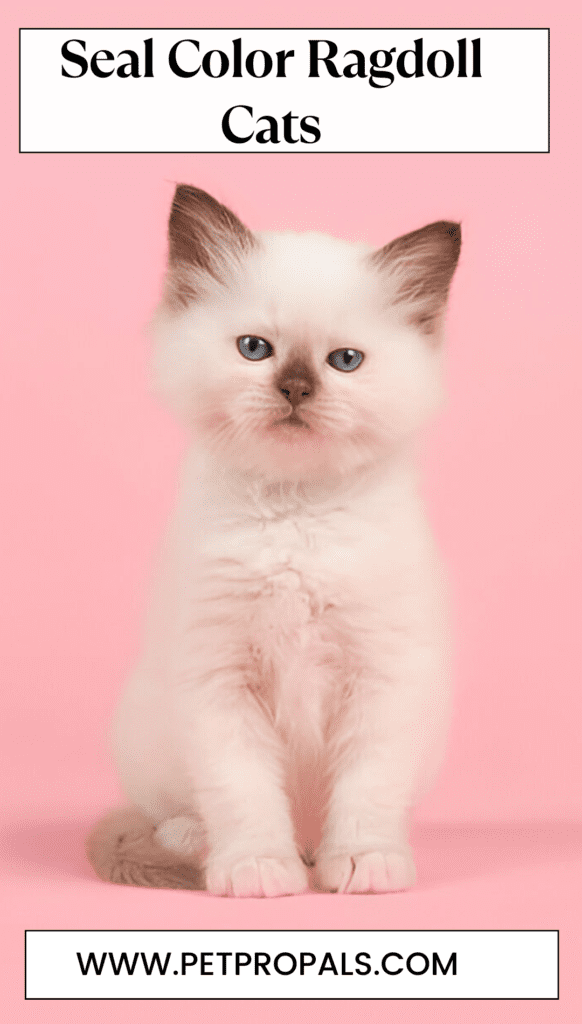
The Seal color pattern in Ragdoll cats features a creamy white body with darker points on the ears, face, paws, and tail.
These points can vary from deep brown to seal brown, creating a sharp contrast. The body fur is lighter, which gives them a unique “pointed” appearance.
Genetic Background
Genetic factors influence the Seal color pattern in Ragdoll cats. The seal color pattern results from the exchange of genes controlling coat color and pattern.
Specific alleles inherited from parents choose the development of the Seal point pattern, aiding breeders in predicting and maintaining desired traits in Ragdolls.
2. Blue Color Ragdoll Cats

The Blue Ragdoll cat is known for its soft, grayish-blue fur with darker blue points on the ears, face, paws, and tail.
This color gives them a gentle and dreamy appearance. The body fur is lighter than the darker points, which creates a noticeable contrast.
Genetic Background
The Blue color pattern in Ragdoll cats comes from specific genes affecting their fur. These genes determine their body fur’s soft blue-gray color and the darker blue points on their extremities.
Breeders focus on these genes to maintain the blue color in Ragdoll cats. Understanding these genetic factors helps breeders preserve and enhance the Blue color in Ragdoll cats from generation to generation.
3. Chocolate Color Ragdoll Cats
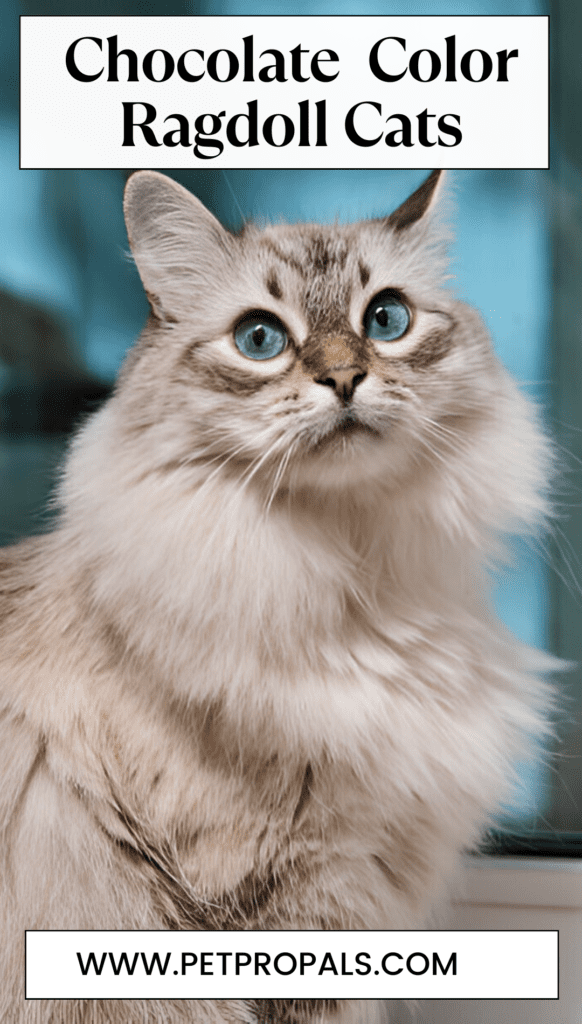
The Chocolate color pattern in Ragdoll cats features a warm, cocoa-colored body with darker chocolate points on the ears, face, paws, and tail. Their fur is soft and glossy, and the contrast between the body and points is striking.
Genetic Background
Ragdoll cats’ chocolate color is determined by specific genes that influence pigment production in their fur. Breeders carefully select these genetic traits to maintain the rich Chocolate coloration.
4. Lilac Color Ragdoll Cats

Ragdoll cats have a lilac color pattern, with a pale, frosty gray body and lilac-gray points on the ears, face, paws, and tail. This color gives them a soft and delicate appearance, resembling a light lavender hue.
Genetic Background
Lilac coloring in Ragdoll cats results from specific genetic combinations that produce the diluted pigment seen in their fur. Breeders focus on these genetic factors to preserve the Lilac color pattern in their breeding programs.
5. Red Color Ragdoll Cats
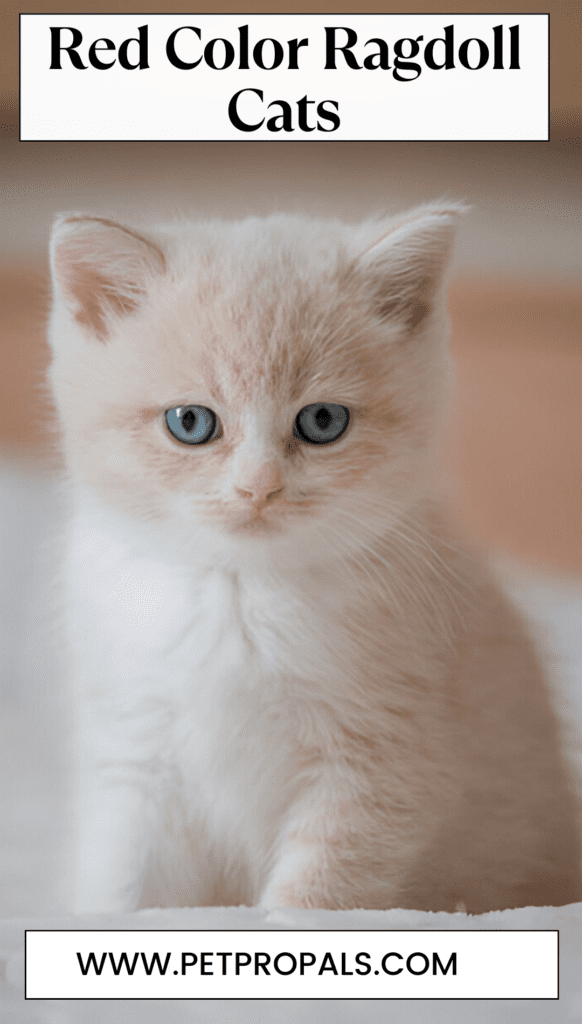
Ragdoll cats have a red pattern that showcases a vibrant, reddish-orange body with darker red points on the ears, face, paws, and tail. Their fur is bold and eye-catching, with a clear contrast between body and points.
Genetic Background
Ragdoll cats’ red color is governed by specific genes controlling red pigment production’s intensity. Breeders select these genetic traits to maintain their cats’ vivid Red coloration.
6. Cream Color Ragdoll Cats
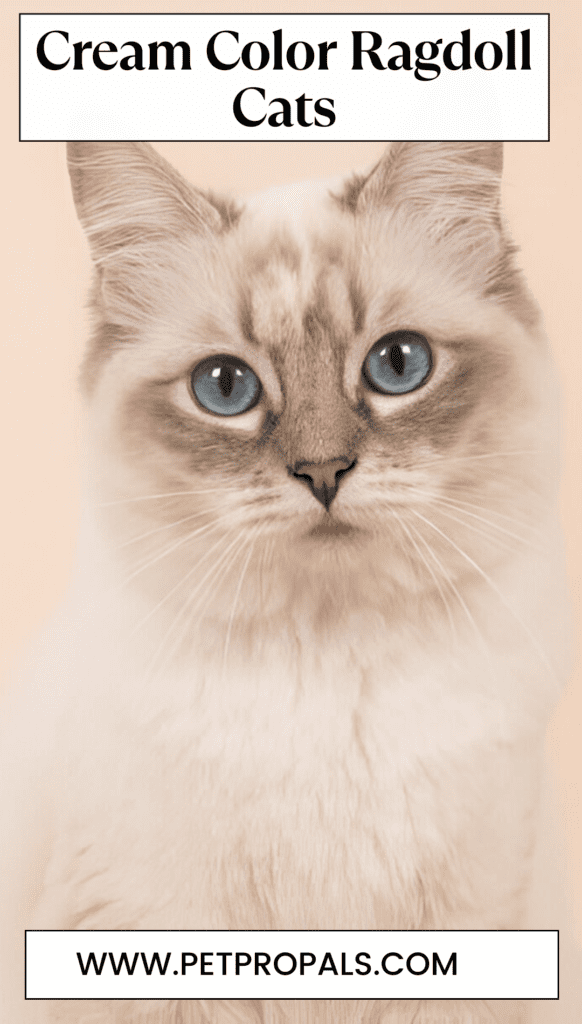
Ragdoll cats have a cream color pattern. Their bodies are pale and creamy white, and the ears, face, paws, and tail have slightly darker cream points. Their fur is soft and light, creating a gentle and elegant appearance.
Genetic Background
Cream coloring in Ragdoll cats is influenced by genes that produce a diluted version of the base color. Breeders focus on these genetic factors to ensure the consistent Cream coloration in their cats.
5 Recognized Patterns of Ragdoll Cat
Ragdoll cats are known for their stunning coat patterns, significantly contributing to their unique appearance and charming personality.
There are five recognized patterns of Ragdoll cats, each with specific characteristics: colorpoint, mitted, bicolor, van, and lynx.
1. Colorpoint Pattern
The Colorpoint pattern in Ragdoll cats features a lighter body color, typically cream or light tan, with darker points on the ears, face, paws, and tail.
These points can be shades of seal, blue, chocolate, or lilac. The body color gradually fades into the points, creating a pointed contrast.
Common Traits and Markings:
- Darker points on ears, face (including mask), paws, and tail.
- Lighter body color that contrasts sharply with the points.
- Blue eyes are familiar but can vary in shade.
2. Mitted Pattern
The Mitted pattern in Ragdoll Cats is a testament to elegance, characterized by the colorpoint pattern with the addition of white mittens on the front paws, sometimes extending to white boots on the hind legs.
They may also have a white chin, bib, and sometimes a white belly stripe. The mask and tail remain darker, like in color points, adding a touch of sophistication to their appearance.
Common Traits and Markings:
- White mittens on front paws and often white boots on hind legs.
- White chin and sometimes a white belly stripe.
- Darker points on ears, face (mask), paws, and tail.
3. Bicolor Pattern
The bicolor pattern in Ragdoll cats showcases a distinctive white inverted “V” shape on the face. They have white legs, chest, and belly, with darker coloring on the back, tail, and the mask area on the face.
Bicolor Ragdolls generally have a mostly white body with patches of darker color, creating a striking and unique appearance.
Common Traits and Markings:
- White inverted “V” on the face (blaze).
- White legs, chest, and belly.
- Darker color on the back, tail, and mask (ears, around eyes, and nose).
4. Lynx (Tabby) Pattern
The Lynx pattern in Ragdoll cats, also known as the Tabby pattern, is characterized by its unique markings on the points (ears, face, paws, and tail).
These markings, which include bold stripes on the legs and tail and a characteristic ‘M’ shape on the forehead, set Lynx Ragdolls apart.
The Lynx Ragdolls can have various base colors (seal, blue, chocolate, or lilac), which influence the color of their tabby markings.
How it Affects Each Color and Pattern:
- Seal Lynx: Has dark brown stripes on a cream or beige background.
- Blue Lynx: Features gray stripes on a light gray or bluish-gray background.
- Chocolate Lynx: Displays lighter brown stripes on a lighter brown or chocolate background.
- Lilac Lynx: Shows faint grayish stripes on a pale lilac or frosty gray background.
5. Tortie (Tortoiseshell) Pattern
The Tortie pattern in Ragdoll Cats, short for Tortoiseshell, is characterized by the random distribution of two distinct colors in patches all over the body.
These colors can be any of the Ragdoll color varieties (seal, blue, chocolate, or lilac).
Typically, Tortie Ragdolls have patches of both darker and lighter colors intermingled, creating a unique and mottled appearance.
How it Affects Each Color and Pattern:
- Seal Tortie: Shows patches of dark brown and cream or tan.
- Blue Tortie: Displays patches of gray and light gray or bluish-gray.
- Chocolate Tortie: Features patches of lighter brown and chocolate or darker brown.
- Lilac Tortie: Presents patches of pale lilac and frosty gray or lighter lilac shades.
Combining Colors and Patterns in Ragdoll Cats
Exploring the intricate relationships between colors and patterns in Ragdoll cats allows us to gain insight into their complicated appearances and various variations, enhancing our ability to appreciate these beautiful felines.
Colorpoint Pattern
- Seal Colorpoint: Creamy body with deep brown points.
- Blue Colorpoint: Pale bluish-gray body with darker blue points.
- Chocolate Colorpoint: Warm cocoa-colored body with chocolate points.
- Lilac Colorpoint: Frosty gray body with lilac-gray points.
Mitted Pattern
- Seal Mitted: Seal points with white mittens and sometimes boots.
- Blue Mitted: Blue points with white mittens and possibly boots.
- Chocolate Mitted: Chocolate points with white mittens.
- Lilac Mitted: Lilac points with white mittens.
Bicolor Pattern
- Seal Bicolor: White inverted “V” on face, white legs, chest, and belly with seal coloring on back and tail.
- Blue Bicolor: White inverted “V” on face, white legs, chest, and belly with blue coloring on back and tail.
- Chocolate Bicolor: White inverted “V” on face, white legs, chest, and belly with chocolate coloring on back and tail.
- Lilac Bicolor: White inverted “V” on face, white legs, chest, and belly with lilac coloring on back and tail.
Lynx (Tabby) Pattern
- Seal Lynx: Creamy body with dark brown tabby stripes.
- Blue Lynx: Pale bluish-gray body with gray tabby stripes.
- Chocolate Lynx: Warm cocoa-colored body with lighter brown tabby stripes.
- Lilac Lynx: Frosty gray body with faint grayish tabby stripes.
Tortie (Tortoiseshell) Pattern
- Seal Tortie: Patches of cream or tan mixed with dark brown.
- Blue Tortie: Patches of light gray or bluish-gray mixed with gray.
- Chocolate Tortie: Patches of chocolate mixed with lighter brown.
- Lilac Tortie: Patches of pale lilac mixed with frosty gray or lighter shades.
The 25 Recognized Combinations
- Seal Colorpoint
- Seal Mitted
- Seal Bicolor
- Blue Colorpoint
- Blue Mitted
- Blue Bicolor
- Chocolate Colorpoint
- Chocolate Mitted
- Chocolate Bicolor
- Lilac Colorpoint
- Lilac Mitted
- Lilac Bicolor
- Red Colorpoint
- Red Mitted
- Red Bicolor
- Cream Colorpoint
- Cream Mitted
- Cream Bicolor
- Seal Lynx
- Blue Lynx
- Chocolate Lynx
- Lilac Lynx
- Red Lynx
- Cream Lynx
- Tortie (applicable within various color groups)
Tips for Identifying Ragdoll Cat Colors and Patterns
Understanding the distinctions among similar colors and patterns is crucial for various tasks, such as interior design, fashion, and art.
One can create visually appealing combinations and avoid clashes by discerning the subtle differences between shades and designs.
Differentiating Between Similar Colors and Patterns
1. Observe Point Color Intensity: Look at the intensity of the color on the ears, face, paws, and tail.
For example, Seal points are much darker than Chocolate points.
2. Check Body Color: Note the overall body color. Blue Ragdolls have a bluish-gray body, while Lilac Ragdolls have a lighter, frosty gray body.
3. Look for White Markings: Mitted and bicolor ragdolls have white markings on the chin, chest, belly, and paws that help distinguish them from Colorpoint cats.
3. Notice Facial Patterns: Bicolor Ragdolls have a distinct inverted “V” on the face, while Lynx (Tabby) Ragdolls may display characteristic tabby markings like stripes on the face and legs.
Tips for Recognizing Lynx and Tortie Variations
When determining different types of cats, it’s essential to notice specific details that separate lynx and tortie patterns.
Lynx variations usually have tabby markings on a lighter background, while tortie variations show patches of red and black (or other colors) in a mottled pattern.
Pay attention to these essential characteristics to accurately tell the differences between lynx and tortie variations in cats.
1. Tabby Markings in Lynx: Look for bold stripes on the legs and tail and an “M” shape on the forehead.
Lynx Ragdolls will have these markings in addition to their point coloration.
2. Mixed Patchwork in Torties: Tortie Ragdolls have patches of two or more colors mixed randomly throughout their coat.
Look for areas where different colors blend, creating a mottled or patchy appearance.
3. Color Intensity Variations: Tortie Ragdolls may have variations in the intensity of their colors within the patches.
Some patches may be darker or lighter depending on the distribution of pigment.
4. Individual Variation: Each Ragdoll cat can have a unique distribution of colors and patterns.
Please familiarize yourself with the general characteristics of each pattern and observe individual variations to identify them accurately.
The Genetics Behind Ragdoll Colors and Patterns
Ragdoll cats’ beautiful colors and patterns are shaped by a sophisticated interaction of genetic factors governing pigment production and distribution in their fur.
This interaction gives rise to various coat colors and patterns, each distinctly unique to every cat.
Color Genes: Ragdoll cats have genes that determine their base coat colors, such as seal, blue, chocolate, and lilac.
These colors are influenced by alleles (variants of genes) that produce specific pigments.
Pattern Genes: Patterns like Colorpoint, Mitted, Bicolor, Lynx (Tabby), and Tortie (Tortoiseshell) are also genetically controlled.
These patterns result from complex interactions of genes that dictate where and how pigment is distributed on the cat’s body.
Alleles and Inheritance: Each Ragdoll inherits one set of genes (alleles) from each parent. The combination of alleles determines the cat’s specific coat color and pattern.
For example, a cat may inherit the allele for seal color from one parent and the allele for mitted pattern from another.
How Breeding Influences Color and Pattern Outcomes
Selective Breeding: Breeders selectively pair Ragdoll cats with desired coat colors and patterns to produce offspring with specific traits.
They choose cats based on their genetic makeup to enhance desirable colors and patterns in subsequent generations.
Understanding Genetics: Breeders use knowledge of genetic inheritance to predict the likelihood of specific coat colors and patterns appearing in kittens.
By understanding each parent’s allele, breeders can estimate the probability of different color and pattern combinations.
Maintaining Standards: Breeding programs follow breed standards that define approved colors and patterns for Ragdoll cats.
These standards ensure consistency and uphold the quality of Ragdolls bred for show and companionship.
Genetic Testing: Some breeders use genetic testing to identify the specific alleles present in their cats.
This can help them make informed breeding decisions to achieve desired coat colors and patterns more reliably.
Conclusion
When you explore Ragdoll cats, you’ll discover a world of genetic beauty and fascination.
Each cat has diverse colors and patterns, from the striking contrasts of Seal and Chocolate points to the soft elegance of Blue and Lilac hues. This makes every Ragdoll cat a masterpiece of genetic artistry.
Understanding these colors and patterns enriches our appreciation for these gentle felines and guides us in making informed choices when welcoming a Ragdoll into our lives.
Different breeds of cats have unique markings that tell a story of their genetic heritage.
Dedicated breeders meticulously uphold breed standards to maintain these variations.
As you explore the world of Ragdoll cats, pay attention to the small details that set one color or pattern apart from another.
Whether you admire, keep as a pet, or breed Ragdoll cats, understanding these distinctions helps you appreciate and celebrate each cat’s uniqueness.
Welcome the charm and variousness of Ragdoll cats, where genetics weave a tapestry of colors and patterns that continue to captivate and enchant cat lovers worldwide, making them a beloved breed across the globe.

